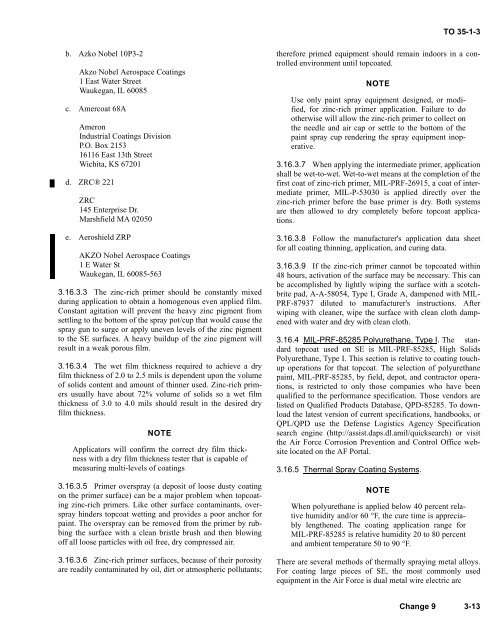TO 35-1-3 - Robins Air Force Base
TO 35-1-3 - Robins Air Force Base
TO 35-1-3 - Robins Air Force Base
Create successful ePaper yourself
Turn your PDF publications into a flip-book with our unique Google optimized e-Paper software.
<strong>TO</strong> <strong>35</strong>-1-3<br />
b. Azko Nobel 10P3-2<br />
Akzo Nobel Aerospace Coatings<br />
1 East Water Street<br />
Waukegan, IL 60085<br />
c. Amercoat 68A<br />
Ameron<br />
Industrial Coatings Division<br />
P.O. Box 2153<br />
16116 East 13th Street<br />
Wichita, KS 67201<br />
d. ZRC® 221<br />
ZRC<br />
145 Enterprise Dr.<br />
Marshfield MA 02050<br />
e. Aeroshield ZRP<br />
AKZO Nobel Aerospace Coatings<br />
1 E Water St<br />
Waukegan, IL 60085-563<br />
3.16.3.3 The zinc-rich primer should be constantly mixed<br />
during application to obtain a homogenous even applied film.<br />
Constant agitation will prevent the heavy zinc pigment from<br />
settling to the bottom of the spray pot/cup that would cause the<br />
spray gun to surge or apply uneven levels of the zinc pigment<br />
to the SE surfaces. A heavy buildup of the zinc pigment will<br />
result in a weak porous film.<br />
3.16.3.4 The wet film thickness required to achieve a dry<br />
film thickness of 2.0 to 2.5 mils is dependent upon the volume<br />
of solids content and amount of thinner used. Zinc-rich primers<br />
usually have about 72% volume of solids so a wet film<br />
thickness of 3.0 to 4.0 mils should result in the desired dry<br />
film thickness.<br />
NOTE<br />
Applicators will confirm the correct dry film thickness<br />
with a dry film thickness tester that is capable of<br />
measuring multi-levels of coatings<br />
3.16.3.5 Primer overspray (a deposit of loose dusty coating<br />
on the primer surface) can be a major problem when topcoating<br />
zinc-rich primers. Like other surface contaminants, overspray<br />
hinders topcoat wetting and provides a poor anchor for<br />
paint. The overspray can be removed from the primer by rubbing<br />
the surface with a clean bristle brush and then blowing<br />
off all loose particles with oil free, dry compressed air.<br />
3.16.3.6 Zinc-rich primer surfaces, because of their porosity<br />
are readily contaminated by oil, dirt or atmospheric pollutants;<br />
therefore primed equipment should remain indoors in a controlled<br />
environment until topcoated.<br />
NOTE<br />
Use only paint spray equipment designed, or modified,<br />
for zinc-rich primer application. Failure to do<br />
otherwise will allow the zinc-rich primer to collect on<br />
the needle and air cap or settle to the bottom of the<br />
paint spray cup rendering the spray equipment inoperative.<br />
3.16.3.7 When applying the intermediate primer, application<br />
shall be wet-to-wet. Wet-to-wet means at the completion of the<br />
first coat of zinc-rich primer, MIL-PRF-26915, a coat of intermediate<br />
primer, MIL-P-53030 is applied directly over the<br />
zinc-rich primer before the base primer is dry. Both systems<br />
are then allowed to dry completely before topcoat applications.<br />
3.16.3.8 Follow the manufacturer's application data sheet<br />
for all coating thinning, application, and curing data.<br />
3.16.3.9 If the zinc-rich primer cannot be topcoated within<br />
48 hours, activation of the surface may be necessary. This can<br />
be accomplished by lightly wiping the surface with a scotchbrite<br />
pad, A-A-58054, Type I, Grade A, dampened with MIL-<br />
PRF-87937 diluted to manufacturer's instructions. After<br />
wiping with cleaner, wipe the surface with clean cloth dampened<br />
with water and dry with clean cloth.<br />
3.16.4 MIL-PRF-85285 Polyurethane, Type I. The standard<br />
topcoat used on SE is MIL-PRF-85285, High Solids<br />
Polyurethane, Type I. This section is relative to coating touchup<br />
operations for that topcoat. The selection of polyurethane<br />
paint, MIL-PRF-85285, by field, depot, and contractor operations,<br />
is restricted to only those companies who have been<br />
qualified to the performance specification. Those vendors are<br />
listed on Qualified Products Database, QPD-85285. To download<br />
the latest version of current specifications, handbooks, or<br />
QPL/QPD use the Defense Logistics Agency Specification<br />
search engine (http://assist.daps.dl.amil/quicksearch) or visit<br />
the <strong>Air</strong> <strong>Force</strong> Corrosion Prevention and Control Office website<br />
located on the AF Portal.<br />
3.16.5 Thermal Spray Coating Systems.<br />
NOTE<br />
When polyurethane is applied below 40 percent relative<br />
humidity and/or 60 °F, the cure time is appreciably<br />
lengthened. The coating application range for<br />
MIL-PRF-85285 is relative humidity 20 to 80 percent<br />
and ambient temperature 50 to 90 °F.<br />
There are several methods of thermally spraying metal alloys.<br />
For coating large pieces of SE, the most commonly used<br />
equipment in the <strong>Air</strong> <strong>Force</strong> is dual metal wire electric arc<br />
Change 9 3-13
















